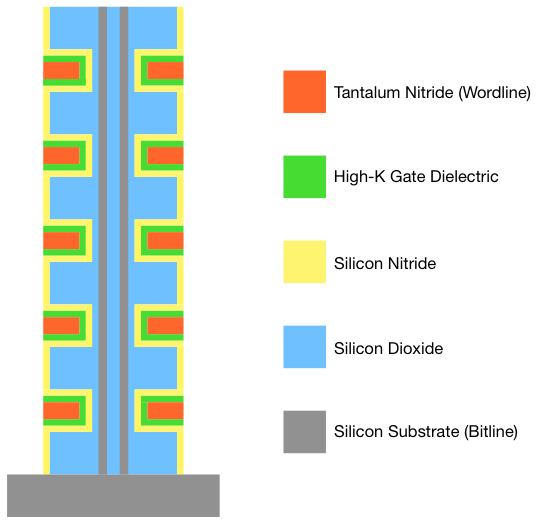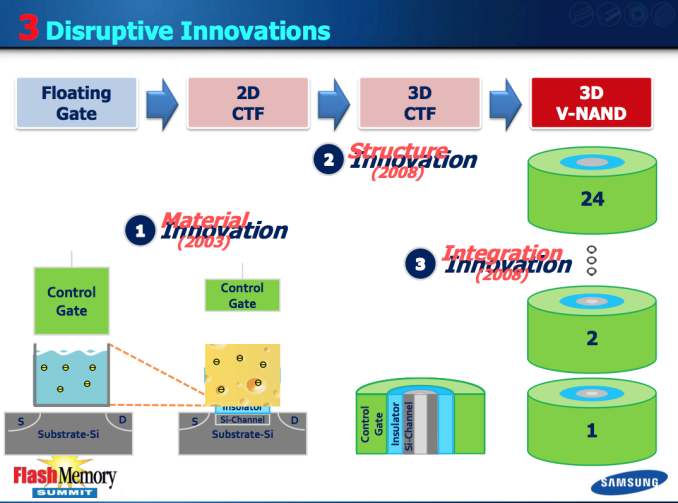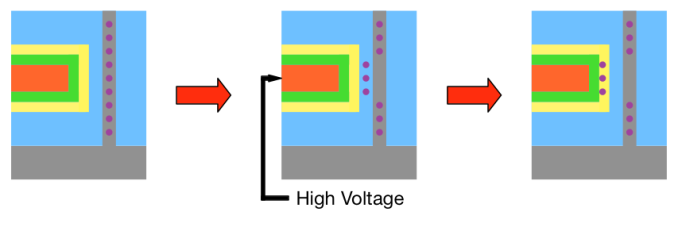Samsung SSD 850 Pro (128GB, 256GB & 1TB) Review: Enter the 3D Era
by Kristian Vättö on July 1, 2014 10:00 AM EST3D NAND: How It Works
To understand how 3D NAND helps to keep Moore's Law in action, we first need to go in-depth with the structure. Before we begin, there are a couple of disclaimers I want to get out. First of all, every manufacturer has a different 3D NAND structure, so to avoid information overflow and confusion, I will only talk about Samsung's structure for now. When other manufacturers are ready with their 3D NAND products, I will provide a similar analysis of their structure. Secondly, there is not much detailed information about Samsung's 3D NAND, or V-NAND as they call it, so I am mostly basing my analysis on The Memory Guy's blog post (also known as Jim Handy, a respected semiconductor analyst).
What you are seeing above is a 5-layer 3D NAND string based on Samsung's TCAT (Terabit Cell Array Transistor) structure. It consists of a total of ten cells and similar to 2D NAND each cell is capable of holding one, two or three bits of data depending on whether the NAND is SLC, MLC or TLC. Samsung's current (i.e. second) generation V-NAND has 32 layers, meaning that it is simply a taller tower but to keep the graph easily readable I decreased the number of layers to five.
There is one fundamental difference between Samsung's V-NAND. With 2D NAND, the charge was stored in a conductive floating gate but as you can see in the graph above, there is not one in Samsung's V-NAND. Instead Samsung uses a design called Charge Trap Flash (CTF), which means that the charge is stored in an insulator, which is silicon nitride in this case.
Some of you might remember this rather hilarious slide we used in our V-NAND announcement article and I now have an explanation as to why Samsung used cheese in in (yes, it indeed is cheese). A traditional floating gate works pretty much like a bucket of water. As long as there is not a hole in the bucket, the water stays there without an issue. However, if you get even a tiny hole in the bucket, all the water will sooner than later escape through that hole. It is the same with a floating gate because if there is a hole in the insulating material around it (Inter Poly Dielectric and tunnel oxide), all the electrons in the floating gate will escape through that as the floating gate is conductive and the electrons can move freely. As I mentioned on the previous page, this is exactly what happens when NAND is cycled and wears out because the stress caused by the programming operation causes the insulators to lose their insulating characteristics.
With Charge Trap Flash that does not happen because the electrons reside in an insulator. Samsung compared the bucket of water idea to cheese, meaning that if there is a hole the cheese will not just pour out from it like water would.
As a result, Charge Trap Flash increases endurance as it is not as vulnerable to wear out. I am also told that CTF does not require as high programming voltages as floating gates do (up to 20V), which reduces the stess on the insulators. I wonder if this is simply because the insulators do not have to be that thick anymore (a miminum of 7nm for tunnel oxide and 12nm for ONO) because the charge trap is not as dependent on the surrounding insulators as floating gate is. The reason why such a high voltage is needed for 2D NAND programming is the thickness of the tunnel oxide because otherwise the electrons cannot tunnel through (remember, the electrons are shot through an insulator). On the other hand, the tunnel oxide cannot be made any thinner than 7nm or otherwise data retention takes a massive hit (NAND is really an engineers dream, isn't it? Touch one thing and you break another).
Another interesting tidbit regarding Samsung’s V-NAND is the usage of a high-K dielectrics. IMFT did a similar switch when they moved to 20nm node but all the other manufacturers, as far as I know, have stayed with an inter poly dielectric (IPD) design. I went into detail about high-K dielectrics in our Crucial MX100 review but I will provide a quick summary here. Basically, a high-K dielectric is a material with a high dielectric constant, which is quite surprisingly known as K. The benefit of a high-K dielectric over a normal dielectric (like oxide-nitride-oxide i.e. ONO in NAND) is that it provides a higher capacitance between the word and bitlines. Similar to 2D NAND, the capacitance between the control gate and the floating gate, or charge trap in the case of V-NAND, is still the key factor for operation. The usage of high-K dielectrics gives Samsung a bit more headroom in terms of vertical scaling as layers can be stacked closer to each other and it also improves endurance as high-K dielectrics have less leakage compared to normal dielectrics.
Otherwise the basics of V-NAND are very similar to 2D NAND. To program a cell, the bitline is grounded (i.e. held at 0V) while a high voltage is placed on the wordline. That makes the electrons that are floating in the bitline to tunnel through the silicon dioxide to the charge trap a.k.a. silicon nitride.
I made a very simple graph of V-NAND programming, which should help you to understand the process. The elements are the same as in the tower graph with the difference that it is just one layer and I cut the tower in half to fit it on the page. The purple balls are electrons.
Reading from V-NAND works exactly the same as with 2D NAND. The wordline of the cell-to-be-read is held at 0V while different voltages are applied on the bitline. Once the correct voltage is found, the cell will conduct and the sense amp will read the data depending on what the voltage was (the voltage determines the voltage state, i.e. what the value is).













160 Comments
View All Comments
frenchy_2001 - Tuesday, July 1, 2014 - link
the 3D structure and design are revolutionary, but the manufacturing technology is actually a very mature one (40nm). This makes it *MUCH* cheaper than the 1X used by their competition.Samsung has really struck gold with that design, as it allows them to scale in both dimensions, depending on the result and cost of each. While 2D NAND is facing really tough challenges to increase density, V-NAND is allowed to either scale up (more layers) or restart scaling pitch, as manufacturing is *very well* understood from 40nm->~16nm. They just need to experiment with it and see what makes economic sense and good trade-offs.
toyotabedzrock - Tuesday, July 1, 2014 - link
Almost seems like it would be cheaper to ramp up the production of silicon ingots and drive that cost down further than the r&d for this.frenchy_2001 - Tuesday, July 1, 2014 - link
Silicon ingots cost is marginal. The real cost for scaling is all the R&D necessary to make the pitch smaller. Even using bigger wafers (current ones are 300mm, there have been talks of 450mm for a while, but cost is a deterrent, as a whole fab needs to be re-tooled for the upgrade) only improves yields and costs marginally.NAND scaling down is facing huge challenges, due both to process (who to image those ~15nm line on a wafer) and electrical limits (~3 electrons inside your cell at 15nm). 3D NAND allows to restart the growth by bypassing those challenges (step back to 40nm process and scale in the Z axis).
General SOCs are facing similar process limits (there is no solution below 10nm so far, despite the whole industry cooperating to find one), even if their design limits are more relaxed (SOCs are not trapping charges, but cross talk and interference are starting to be challenges too).
UltraWide - Monday, June 30, 2014 - link
Will there be a version with PCIe or M.2?Gigaplex - Monday, June 30, 2014 - link
If you'd read the article, you'd know the controller doesn't support PCIe.Gigaplex - Monday, June 30, 2014 - link
"This further suggests that the issue lies in our tests instead of the RAPID software itself as end-users will always run the drive with a partition anyway."Um, no. I don't care what the end user does, the software shouldn't cause a BSOD. If it can't cache without a partition, it should simply not attempt to cache. This is just a case of Samsung thinking that just because they do some nice hardware, that they're experts in software. They're really not. RAM caching of I/O isn't specific to SSDs anyway, why are they tying it to an SSD launch?
Donuts123 - Wednesday, July 2, 2014 - link
Yeah, that's a huge red flag for me, I definitely wouldn't use the RAPID software. Another layer to go wrong (and apparently it does). I hope Anandtech submits details of the BSODs they saw to Samsung.RAPID probably just uses the Samsung SSD as a dongle. Presumably RAPID is derived from Samsung's acquisition of NVELO, see http://www.anandtech.com/show/6518/samsung-acquire...
Guspaz - Monday, June 30, 2014 - link
Wait a minute, 150TB endurance on a 1TB drive? Only 150 cycles? That doesn't make any sense, that's absurdly low.Then again, Intel's rating for the 335 doesn't make any sense either. They say 20GB a day for 3 years, or about 22TB... But they also rate it for 3000 cycles, and the media wear indicator on the drive is set to treat 3000 as full wear, and that represents 720TB...
Kristian Vättö - Tuesday, July 1, 2014 - link
The endurance figures are usually based on a 4KB random write workload and are thus worst-case numbers. 150TB of random writes means a ton of more NAND writes than 150TB, that's why. I explained the calculation of TBW here:http://www.anandtech.com/show/7947/micron-m500-dc-...
However, as I mentioned in the article, in the client space the endurance is more for guidance (i.e. don't put these in servers!) than an actual technical limit.
emn13 - Tuesday, July 1, 2014 - link
...but outside of server-like workloads, what's going to benefit from this performance?